English Assignment: Recording & Sharing Interpretations of Student Data in Early Years
Question
Task: English Assignment Part 1: Preservice teachers will be provided with a set of classroom assessment data including results of diagnostic tests as well as the results from formative and summative reading assessment tasks. Preservice teachers will analyse and interpret a class set of data for general trends and write a professional report on the reading achievement of the students in the class, identifying strengths and needs of the class in terms of the following reading skills: phonemic awareness, phonics, fluency, vocabulary, comprehension and oral language.
English Assignment Part 2. Preservice teachers will then examine data related to one student drawing from the class set provided in Part 1, positioning the student in relation to established benchmarks in reading. In small groups of two or three, preservice teachers will engage in a moderation process and discuss their findings and judgements to create a reflection on the moderation process and create an action plan to further support a student’s reading development and needs.
Answer
Introduction
Analysis of pertinent data in the primary classroom as performed in this English assignment can reveal crucial aspects regarding the attainment of the lesson. In this current analysis, data from Queensland Government State School primary metropolitan sector has been undertaken. The school size comprises 720 students with 25 classes. The primary state school is a non-denominational, co-educational school located in the suburbs of south-east Queensland. The focus of the school is on the development of numeracy and literacy, along with several extracurricular programs. Analyzing relevant data from the classroom can provide a powerful tool in the education journey. The data can provide the relevant association with experience as well as enhancement of assessing the education of students in an individualized manner. Teaching needs to include the 'Big 6 skills' of reading such as phonemic phonics, awareness, fluency, comprehension, vocabulary, and oral language that are supported by the Australian Curriculum.
Part 1 Discussion (Data set analysis and Identification of Strengths and Needs of the Class)
Analyzing data of students can enable informing, engaging, and creation of opportunities for students in their individualized educational journey. Through the analysis of data, it will be possible to make associations that can enable assisting students in an individualized manner. Queensland Government State School, a primary co-educational school enhances student's literacy by focussing on the development of numeracy and literacy. Analyzing the demographic area that the school caters to; it is seen that the students are mostly from low to middle socio-economic areas.
They come from varied ethnic and cultural backgrounds. Data collected from MySchool data (2020) reveals that almost as high as 42% of students come from language backgrounds other than English with only 3% being indigenous students. Students at the school can speak in different languages from 49 different countries. The school provides language support to this diversified student through the EALD program. The pedagogical framework adopted in the school includes adopting a positive behavior for a learning approach that promotes a positive attitude to learning in the classroom as well as in the playground. The school follows the Australian Curriculum guidelines for the Learning Sequences, whereby the teachers make use of the AITSL standards for guiding their professional approach in the classroom (De Courcy et al., 2012). In this current discussion, student characteristics in Year 1 class have been taken into consideration. The class composition includes a student diagnosed with ASD, another with hearing impairment requiring the teacher to wear a support device, and four students, whose family speaks in languages apart from English.
The students were made to participate in a sequence of lessons, where they explored texts connected to brolgas and Aboriginal dance connected to brolgas. The students were made to view a split-screen video that shown the simultaneous performance of a brolga dance and Aboriginal dancers. Post disusing ways in which the dancers learned to dance; the students were given the task to reflect on their personal experience of learning to perform something. According to the Australian Curriculum framework, the English language curriculum is based on three interrelated areas: language, literature, and literacy (Montag et al., 2015). Education and training should balance and integrate all three strands. Resources are used to improve students' knowledge, understanding, and skills in listening, reading, reading, writing, writing, and creating students (Fears et al., 2020). Concepts, skills, and processes developed in the field of English learning in recent years are theories, skills, and processes that teachers review and strengthen when needed. In first grade, students communicate with classmates, teachers, adults, and students of other classes. The students try out different texts for fun (Konza, 2016). Listen, read, view, and interpret conversation, written, multi-propaganda text designed for entertainment and information. These include traditional oral texts, including indigenous stories, picture books, various types of stories, rhythmic poems, poems, non-coagulations, films, dramatic phrases, and texts with which students model their own text. The strands emphasises on the development of phonemic awareness, fluency, phonics, vocabulary, comprehension as well as oral language. In the current scenario, the data of Yoshiro has been analyzed.
The Foundation's literary texts are up to 10 years old to draw Australian literature into Oral Narrative Traditions of the Aboriginal and Torres Strait Islander Peoples, as well as contemporary and classical and contemporary world literature from both cultural groups, including Asian and Asian literature. The literary text, which supports and expands first-graders as independent readers, contains a simple set of everyday events and events that are recognizable with realistic or creative features. The information text represents a small amount of new content on known topics and topics that are covered in other areas of the course (Poortman, and Schildkamp, 2016). These include the deciphering and predictable text, which represents a small number of language characteristics, including simple and combined sentences, unknown words, a small number of high-frequency words and words that must be decrypted by sound, and illustrations and diagrams such as printed text (Maldarelli et al., 2015).
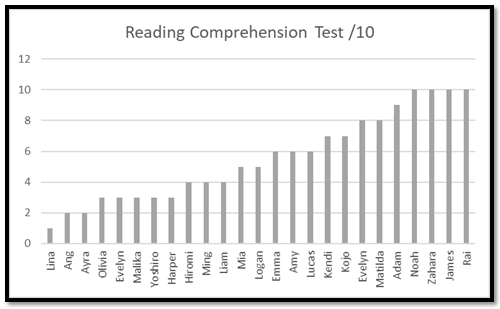
Figure 2: Reading Comprehension Classroom Performance
Source: Author
Understanding requires a commitment to deep text and skills that go far beyond simple word recognition in reading comprehension. Figure2 shows the bottom of the picture with a total test score of 25 students, and there are students who have achieved this particular test. As seen above the table below reading is strength of the student. This particular student does not have reading understanding, and the overall strength is very weak, 4/25 students received 100% of the exam, only 11/25 students fail the exam, which is less than half the class. The first five components of reading the "Big Six" contribute to understanding the ultimate purpose of reading and the degree to which each aspect is created to influence the reader's understanding. It is a rich understanding that distinguishes the original or the bad reader from mature readers. Understanding is the ultimate goal of reading and is located on top of six pyramids (Lai et al., 2014).
For reading basic knowledge of semantics and synthesizer structural information helps predict the relationship between words. Since the student failed grade score, one strategy that can be used to improve understanding is to read it themselves.
At the end of the first year, students understand the various objectives of the text. By explaining how people and important events are in essays, they come into contact with personal experiences. They found that the texts had other purposes that influenced their organization. With the development of fluency, the students read aloud (Puglisi et al., 2017).
Reading essays with unknown words, simple, complex expressions, and supporting images. When reading, they use knowledge of sound and letters, high-frequency words, punctuation marks, and imagination to create meaning. They remember important ideas and recognize the literal and implicit meaning of the text. Students understand how characters develop in the text and justify personal preferences. By creating text that shows how to understand the connection between writing, language, and images.
Solid maternal language teaching is an indicator of the success of EAL/D student schools. There are children in the class who read English on their own, and their native language helps EAL/D students create languages and skills in both dialects (Puranik et al., 2013). Independent text reading can provide a huge collection based on the level of understanding and interest of students, such phonemic awareness or large repetitions of words. Reading is an important supporter of many language and intellectual skills, especially in the dictionary.
When readers reread familiar text or decipher a minimized text, they can focus more on making sense. Independent reading is an activity that allows readers to support the learning process (Thomson et al., 2013). Participating in the reading of notes, students can not only work on ways to pay and understand dismissal but also practice and strengthen the line, work to view privacy, and think through messages. Therefore, by participating in the reading of notes, students can not only practice decoding and understanding strategies, but also strengthen and strengthen their vocabulary, practice their reading skills, and think critically about the text.
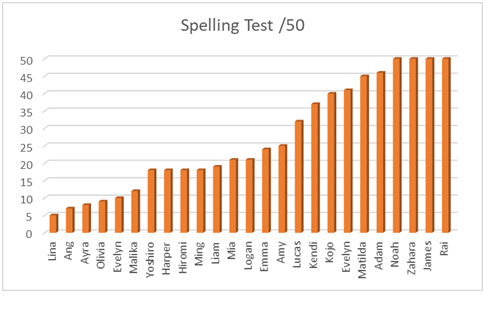
Figure 3: Spelling Test Class Performance
Source: Author
The student scored 18 out of 50 on a spelling test, thus failing this test again. Hence he requires considerable practice to improvise his writing skills. Spelling is a weakness of the student with most students not performing well.
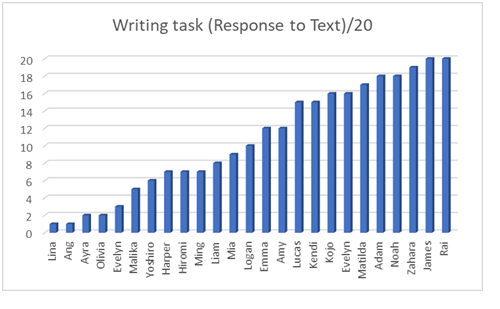
Figure 4: Writing task class performance
Source: Author
The student seems to lack spelling and writing, which is reflected in the assessment of the homework results they form and summarize, and thus the disadvantages of spelling and writing. The student is seen to perform badly in writing tasks as well as getting 6 out of 20 in the assessment. Although the students have a strong understanding, they seem to lack a sense of sound and acoustics. The most important factor in spelling development is the perception of the individual sound of phonetics, and the awareness of phonetics (Hamilton et al., 2016).
Writing is also a weakness of the students. Studies have shown that reading and playing are based on almost the same knowledge which includes the relationship between letters and sounds (Robins et al., 2014). Spelling can be developed to better understand the most important reading skills. Spelling and reading are based on the same psychological image of the word. An understanding of word spelling allows the reading of surfaces to access this performance (Puranik et al., 2014). Students remember a limited number of words, unless the concepts of alphabet principles, phage awareness, and morphology are developed.
Playing requires teachers to systematically provide information about news, language and meaning. In return, they encourage students to remember all the words used to write and read to a person. Spelling helps students read, vocabulary, and write (Fricke et al., 2016). The discussion of new information has accelerated retention, promoted the application of knowledge in new situations, and developed overarching thinking. For example, writing a scripture diary can be a strategy to improve children's writing and spelling skills by promoting memory and establishing connections to thoughts, feelings, thoughts, and learned evidence (Kandel, &Perret, 2014). Targeted and thoughtful use of pedagogical considerations can help to set and achieve goals. Children find themselves in a situation where they know the words they want to write, they say them out loud, they hear voices, they choose letters from their paper knowledge memories, and they hear sounds. This means that writing deliberately forces young writers to listen to the sounds of the words they want to write and tries to choose the letters that represent those sounds.By participating in the spelling process of the invention, children learn more about the relationship between tone and letter. They applied the principles in alphabetical order.
Part 2 Discussion (Moderation and Action Plan for ONE Student)
The students attended a series of courses related to Brolgas and Aboriginal dancers. Yoshiro received 6/20 of the writing assignment, 18/50 for the spelling test, and 3/10 for reading comprehension. Figure 1 below depicts the attainment levels of Yoshiro in writing tasks, spelling tasks, and reading comprehension collectively, which has later been analyzed, discussed, and compared against the class performance. The student is seen to score 6 in writing tasks, 18 in spelling tests, and 3 in reading comprehension.
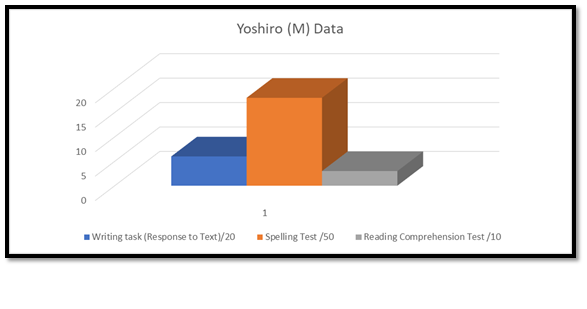
Figure 1: Data Analysis of Yoshiro
Source: Author
She still seems to have relationships and is "still aware" because at the time of writing it is clear that she is able to make a fragmented relationship with personal experiences, fragmented details of ideas, events, and participants of the event. He is also able to spell words at high frequencies with regular spelling patterns, as shown in the spelling test results. She has fragmentary memories of thoughts and the recognition of concepts in the text. Her power does not understand reading because he could not answer long questions at the end of the text. The content of the curriculum was beginning to be realized; basic knowledge of the aspects of the necessary knowledge; skills in situations they know.
At the end of the first year, the students understand the different purposes of the texts. By explaining characters and important events in short texts, they are made with personal experience (Bleses et al., 2018). In different types of literature, they describe the characters, settings, and events, which need to be adopted for Yoshiro. She needs to read aloud as the curriculum progressed. They read short texts with unknown vocabulary, simple and composed sentences, and supporting images (Fears et al., 2018). When reading, they use knowledge of the relationship between sounds and letters, high-frequency words, punctuation marks, and directness to create a report. They remember important ideas and recognize the literal and implicit meaning of texts (Fisher et al., 2016). They listen to others when they talk to the right language elements and interaction skills.
|
Outcome/Target/Skills |
Teaching Emphasis & Aims |
Strategies |
Classroom Management (e.g., whole class/individual/group)
|
Progress/Evidence/Assessment |
|
1. Enhance literacy
2. Increasing reading skills
3. Increasing writing capabilities |
Improving literacy in English for EAL/D students
Enhancing reading skills in English for EAL/D students
Enhancing writing in English capabilities for EAL/D students |
Comprehending Comprehension
Asking students to read a passage
Students are given to write answers, spellings, etc
|
Whole class
Whole class
Whole class |
Test scores
Test scores
Test scores
|
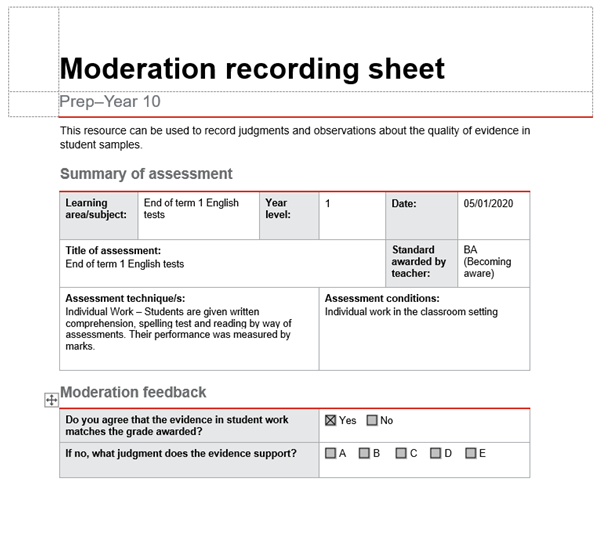
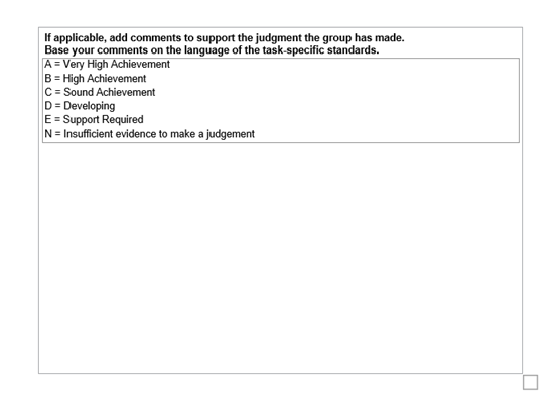
Conclusion
According to the Australian Curriculum framework, the English language curriculum is based on three interrelated areas: language, literature, and literacy. Education and training should balance and integrate all three needles. Resources are used to improve students' knowledge, understanding, and skills in listening, reading, reading, writing, writing, and creating students. Concepts, skills, and processes developed in the field of English learning in recent years are theories, skills, and processes that teachers review and strengthen when needed. This will enable the students to understand how characters develop in texts and justify personal preferences. They form short texts for a variety of purposes. They communicate in pairs, groups, and classes and react alternately. They give short lectures on well-known topics. As students write, students provide detailed information about ideas or events, as well as detailed information about event participants. They advertise precisely with high-frequency words and words with regular spelling patterns. They need to use letters and full breakpoints, and they make all the upper letters of the case good.
References
Bleses, D., Højen, A., Justice, L. M., Dale, P. S., Dybdal, L., Piasta, S. B., . . ., &Haghish, E. F. (2018). The effectiveness of a large-scale language and preliteracy intervention: The SPELL randomized controlled trial in Denmark. Child Development, 89(4), e342–e363.
De Courcy, M., Dooley, K., Jackson, R., Miller, J., Rushton, K. (2012).Teaching EAL/D learners in Australian classrooms, PETAA Paper 183, Primary Teaching Association Australia.
Fears, N. E., &Lockman, J. J. (2018).
How beginning handwriting is influenced by letter knowledge: Visual–motor coordination during children’s form copying. Journal of Experimental Child Psychology, 171, 55–70.
Fears, N. E., Walsh, L. E., &Lockman, J. J. (2020). Letter writing instruction for children: Case-sensitive letter frequencies in children’s handwriting workbooks. Reading and Writing: An Interdisciplinary Journal, 33, 171–185. http://dx.doi.org/10.1007/s11145-019-09954-7
Fisher, D., Frey, N. and Hattie, J. (2016). Visible learning for Literacy: Implementing practices that work best to accelerate student learning. Thousand Oaks, California: Sage Publications.
Fricke, S., Szczerbinski, M., Fox-Boyer, A., & Stackhouse, J. (2016).Preschool predictors of early literacy acquisition in German-speaking children.Reading Research Quarterly, 51(1), 29–53.
Hamilton, L. G., Hayiou-Thomas, M. E., Hulme, C., &Snowling, M. J. (2016).The home literacy environment as a predictor of the early literacy development of children at family-risk of dyslexia. Scientific Studies of Reading, 20(5), 401–419. http://dx.doi.org/10.1080/10888438.2016.1213266
Kandel, S., &Perret, C. (2014). How do movements to produce letters become automatic during writing acquisition? Investigating the development of motor anticipation. International Journal of Behavioral Development, 39(2), 113–120. http://dx.doi.org/10.1177/0165025414557532
Konza, D. (2016). Understanding the reading process: The big six, In J. Scull and B. Raban (Eds.), Growing up literate: Australian literacy research for practice (pp.149 - 176). Hong Kong: Eleanor Curtain Publishing.
Lai, M. K., A. Wilson, S. McNaughton, and S. Hsiao. (2014).
“Improving Achievement in Secondary Schools: Impact of a Literacy Project on Reading Comprehension and Secondary School Qualifications.” Reading Research Quarterly 49 (3): 305–334. doi:10.1002/rrq.2014.49.issue-3.
Maldarelli, J. E., Kahrs, B. A., Hunt, S. C., &Lockman, J. J. (2015). Development of early handwriting: Visual-motor control during letter copying. Developmental Psychology, 1(7), 879–888.
Montag, J. L., Jones, M. N., & Smith, L. B. (2015). The words children hear: Picture books and the statistics for language learning. Psychological Science, 26(9), 1489–1496.
Poortman, C. L., and K. Schildkamp. (2016). “Solving Student Achievement Focused Problems with a Data Use Intervention for Teachers.” Teaching and Teacher Education 60: 425–433. doi:10.1016/j.tate.2016.06.010.
Puglisi, M. L., Hulme, C., Hamilton, L. G., &Snowling, M. J. (2017). The home literacy environment is a correlate, but perhaps not a cause, of variations in children’s language and literacy development. Scientific Studies of Reading, 21(6), 498–514. http://dx.doi.org/10.1080/10888438.2017.1346660 Puranik, C. S., Petscher, Y., &Lonigan, C. J.
(2013).Dimensionality and reliability of letter writing in 3- to 5-year-old preschool children. Learning and Individual Differences, 28, 133–141.
Puranik, C. S., Petscher, Y., &Lonigan, C. J. (2014).Learning to write letters: Examination of student and letter factors. Journal of Experimental Child Psychology, 128, 152–170.
Robins, S., Treiman, R., & Rosales, N. (2014).Letter knowledge in parent-child conversations. Reading and Writing, 27(3), 407–429.
Thomson, S., Hillman, K. & De Bortoli, L. (2013).A teacher’s guide to PISA reading literacy. Camberwell, Vic: ACER.












